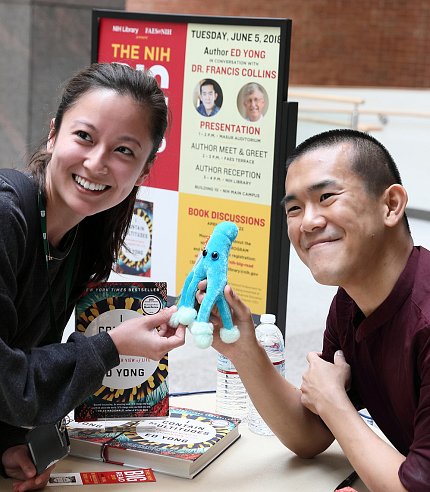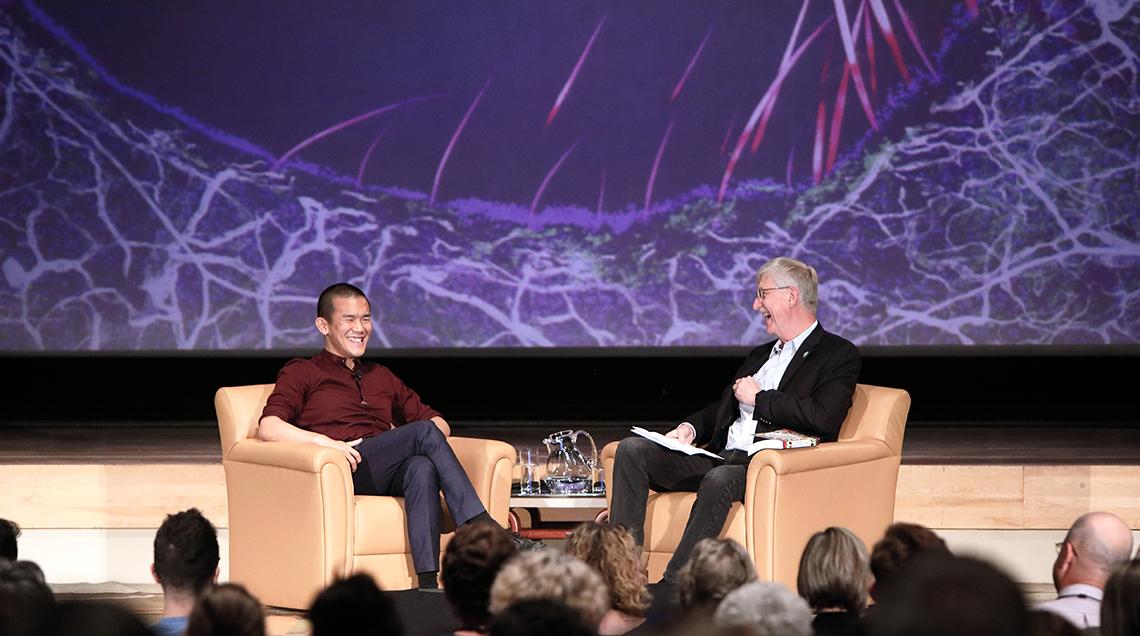Germ Theory
Yong Discusses Wonderful World of Microbes

Photo: Chia-Chi Charlie Chang
The topic is quite infectious, though most kinds of microbes are not. We’re colonized by trillions of bacteria and other microbes, the bulk of them beneficial or harmless. Fewer than 100 species of bacteria can even cause infectious diseases in people, writes author Ed Yong in his bestselling book I Contain Multitudes: The Microbes Within Us and a Grander View of Life.
Yong, a British science writer living in Washington who writes regularly for The Atlantic, recently sat down with NIH director Dr. Francis Collins to discuss his book at the second annual Big Read. This giant book club event in Masur Auditorium followed weeks of informal book discussions at the NIH Library among interested staff.
In writing I Contain Multitudes, a title borrowed from a line in the Walt Whitman poem Song of Myself, Yong said he wanted to convey that microbes aren’t just bugs that make us sick. They’re the dominant form of life on the planet, he said. They’re everywhere and they do interesting things.
“Microbes are fascinating to me; they’re sort of natural underdogs,” said Yong. “They’ve been feared and reviled for a very long time and we’re starting just now to understand how important they are…It’s fodder for a lot of good narrative.”
A story he recently covered for The Atlantic highlights the tenuous relationship among microbes, hosts and the environment. The mystery involved saigas, Central Asian antelope, whose globular noses Yong likened to a Dr. Seuss character. In 2015, two-thirds of the entire population died within a couple of weeks in a land area the size of Florida. The culprit turned out to be a normally harmless bacterium that lives in the saiga’s nasal cavities but became lethal when it seeped into their bloodstream. The microbes went haywire, it’s believed, in response to extreme climate fluctuations.

Photo: Chia-Chi Charlie Chang
“Relationships between hosts and microbes are often on this knife’s edge between disease and health, between parasitism and commensalism [peaceful coexistence], and that can tip easily,” said Yong. It’s a reminder, he added, that the microbe-host relationship may evolve as the world around us changes.
Most of Yong’s book focuses on how the microbiome works, develops and can be manipulated in humans and animals. The last chapter is devoted to microbes in the environment. Do our choices, from building design to sterilizing surfaces, contribute to the spread of pathogens? It’s an area of ongoing debate.
Regardless, Collins interjected affably, nothing said during the conversation absolves NIH clinicians from handwashing.
Throughout the Big Read, Yong and Collins discussed the art of making science writing dynamic and comprehensible.
“A lot of people think of science as a set of discoveries or papers, but it’s so much more than that,” said Yong. “It’s stories of successes and failures; it’s the motivations that got people into this in the first place; it’s tales of feeling out of place or curious about something and these human universals that make science so compelling.”
One microbial procedure with mixed results is fecal transplant. Transferring the microbiome contained within poop from a healthy donor to a patient has proven effective in fighting Clostridium difficile, a bacterial infection often resistant to antibiotics. So far, though, said Yong, fecal transplant has much less success against other types of infection.
“Altering someone’s microbiome is as complicated as changing a rain forest or a coral reef,” he said.
A major drawback of fecal transplant, apart from the ick factor, is that the donor’s stool can transfer all kinds of diseases. The therapy might solve one condition but impart others, said Yong, so it’s critical to explore regulatory issues and long-term risks.
Another promising area is disease control. Many insects, and some mosquito breeds, carry bacteria called Wolbachia. While scientists were studying the organism’s reproductive properties, they discovered that the kinds of mosquitoes that don’t carry Wolbachia are the ones that carry and spread dengue, yellow fever and Zika virus.

Photo: Chia-Chi Charlie Chang
In clinical trials in tropical areas worldwide, scientists are injecting small groups of pathogenic mosquito breeds with Wolbachia and releasing them into the wild. Potentially, after a few generations, these mosquitoes will naturally carry the bacteria and no longer be vectors for human disease.
“I think it’s an interesting example of basic research having these unexpected and wonderful applications,” said Yong.
The investigators have had to tread carefully, though, since conducting such experiments in nature is bound to create public concern. “You’re basically saying to people: we want to release mosquitoes on your property,” said Yong. “They’ve been loaded up with bacteria they don’t normally have...Those insects will probably bite you. Are you cool with that?”
Uncertainties abound in science, said Yong, and can make for illuminating stories.
“I don’t think you need to tell people you’re going to change their lives or change the world to get them excited about science,” he said. One of his most widely read articles, he noted, concerned hippo dung.
Writing a book is a lonely endeavor and there’s the underlying fear it won’t sell, said Yong.
“I wrote the book because I thought it would be an intellectually satisfying exercise and I was going to be proud of the product regardless of how well it did. Everything on top of that is a bonus.”
